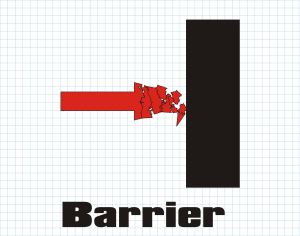Acoustical Building Block #3 – Acoustical Isolation
Acoustical Barrier
 In the last episode, we examined the role diffusion plays as an acoustical tool. Today we’ll discuss barrier, or acoustical isolation. This is used to reduce or eliminate sound intruding from one space into another through the air. A prime example of this, for you film sound buffs, is when the sound from a mix stage (invariably mixing a heavy action film) finds its way into a Foley stage (invariably trying to record cloth movement).
In the last episode, we examined the role diffusion plays as an acoustical tool. Today we’ll discuss barrier, or acoustical isolation. This is used to reduce or eliminate sound intruding from one space into another through the air. A prime example of this, for you film sound buffs, is when the sound from a mix stage (invariably mixing a heavy action film) finds its way into a Foley stage (invariably trying to record cloth movement).
Now, some folks may think that since acoustical isolation doesn’t directly affect the perceived sound in a sonically sensitive space, it shouldn’t be considered an acoustical tool. I would say acoustical isolation is indeed pertinent, as when someone comes into your workspace complaining about how they can’t hear themselves think with all your “noise” going on. It very definitely affects the acoustics; it’s hard to hear the nuances of your mix over the yelling.
Acoustical isolation is used to keep your pet project from becoming someone else’s noise, or being contaminated by that noisy S.O.B. in the next room. It’s about containment, it’s about courtesy, it’s about keeping that volatile person from doing bodily harm to you.
Acoustical isolation can be incorporated into the walls and other surfaces of a room through good design and material selection. It can also be partitions or barriers added in the attic or in the crawl space under a floor to block flanking sound from traveling through those open spaces.
The traditional way to block sound intrusion is with mass. This is a fancy way of saying the more something weighs, the more energy it takes to move it. And the more energy it takes to move something, the less sound it will transmit. This is why the really high end studios make walls out of cinder blocks filled with concrete. A lot of sound has to hit THAT wall to find its way into the next room.
But very few of us can afford cinder block studios. So another popular acoustical isolation material is good old drywall. It’s got mass, it’s cheap, and there are a lot of skilled trades people who can work with it. Drywall is also very adaptable – you can you build up multiple layers to get more acoustical isolation, and use soundboard or resilient channel between layers.
One of the most effective techniques used in large studios is building a second insulated wall with an airspace between the two. Taking this to its logical conclusion is the practice of building a “room within a room”. This provides the extra attenuation of double walls, as well as a double ceiling. It’s expensive, but when you’ve really got to keep your sound contained, this is a sure fire method. There’s also the “staggered stud” wall; a 2X6 plate and header with 2X4 studs. Each drywall sheet is not directly connected to the sheet(s) on the opposite wall through a stud, except through the plate and header. This removes a structural path where acoustical energy striking the drywall on one side is transmitted to the drywall on the other side (more on this in the next Acoustical Building Block).
The “poor man’s” method of getting improved decoupling between each side of a wall is to install a second layer of drywall mounted on resilient channel.
How well a wall or barrier attenuates sound trying to pass through it is referred to as its Sound Transmission Class, or STC. This is a number used to compare how well different walls, barriers and acoustical isolators work. So when you’re reading the STC’s for different thicknesses of drywall, mass loaded vinyl, or other materials/wall designs, this number gives you a common point of reference.
But it is also easy to be fooled by this number. Every material transmits different frequencies at different levels, because of its characteristics at different wavelengths. So the STC gives you a useful single point of reference to compare, but if your acoustic space will have lots of low frequency sound, you’ll get far less perceived transmission loss than the number might lead you to think.
Low frequencies are particularly important to pay attention to. Ask anyone who has been on the receiving end of sound intrusion, and they will tell you what bothers them most is the low frequency information, characterized by the words “thump” and “rumble”.
If you’re working on a room that will have lots of low frequency sound, or has neighboring rooms that are sonically sensitive for any reason, it’s best to research what the actual numbers are by frequency band. That will give you a more accurate idea of what to expect in the low frequency area where you will need the most help. Most material manufacturers can provide this information; some, like Owens Corning, also have lots of other helpful acoustical information for you.
Now after telling you all of this, I have to say that there is another path for sound to intrude from one room to another. It is sneaky, it is sly. It is the sound that travels through the physical structure of the room in the form of mechanical vibration. Which brings us to the next acoustical tool – vibration isolation. Tune in soon for the “exciting” story behind this!